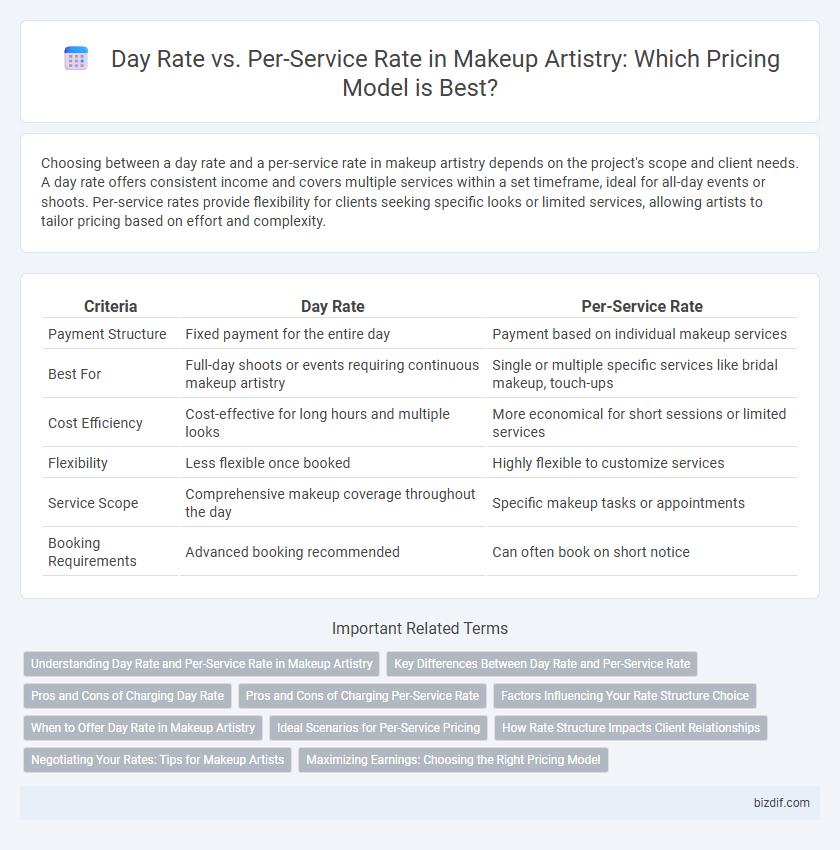Choosing between a day rate and a per-service rate in makeup artistry depends on the project's scope and client needs. A day rate offers consistent income and covers multiple services within a set timeframe, ideal for all-day events or shoots. Per-service rates provide flexibility for clients seeking specific looks or limited services, allowing artists to tailor pricing based on effort and complexity.
Table of Comparison
| Criteria | Day Rate | Per-Service Rate |
|---|---|---|
| Payment Structure | Fixed payment for the entire day | Payment based on individual makeup services |
| Best For | Full-day shoots or events requiring continuous makeup artistry | Single or multiple specific services like bridal makeup, touch-ups |
| Cost Efficiency | Cost-effective for long hours and multiple looks | More economical for short sessions or limited services |
| Flexibility | Less flexible once booked | Highly flexible to customize services |
| Service Scope | Comprehensive makeup coverage throughout the day | Specific makeup tasks or appointments |
| Booking Requirements | Advanced booking recommended | Can often book on short notice |
Understanding Day Rate and Per-Service Rate in Makeup Artistry
Day rate pricing in makeup artistry offers clients a fixed fee for full-day services, ensuring consistent availability and comprehensive looks for events like weddings and photoshoots. Per-service rate charges makeup artists based on individual services such as bridal makeup, touch-ups, or special effects, providing flexibility and customization for clients with specific needs. Understanding these pricing models helps both artists and clients balance budget considerations with the scope and duration of makeup services.
Key Differences Between Day Rate and Per-Service Rate
Day rate pricing in makeup artistry involves a fixed fee for the entire duration of a workday, covering multiple services or looks, providing predictability for both artist and client. Per-service rate charges are calculated individually for each makeup application or specific service, allowing clients to pay only for what they need, which can offer flexibility but less cost predictability. Key differences include the scope of work covered, pricing structure, and payment flexibility, with day rates suited for extended projects and per-service rates ideal for single or occasional services.
Pros and Cons of Charging Day Rate
Charging a day rate in makeup artistry ensures consistent income for extended bookings and simplifies client budgeting, but it may undervalue shorter sessions or rushed jobs. This pricing method rewards efficient workflows and full-day commitments, yet risks losing clients who prefer paying only for specific services. Makeup artists must balance steady revenue with potential undercharging for minimal or quick services when opting for a day rate structure.
Pros and Cons of Charging Per-Service Rate
Charging a per-service rate in makeup artistry offers clear benefits such as transparent pricing and flexibility for clients seeking specific treatments, enhancing customer satisfaction and targeted service offerings. However, it can lead to inconsistent income and challenges in estimating time and effort accurately, potentially resulting in undercharging for complex services or overbooking. Artists must balance competitive pricing with service quality to maintain profitability and client trust.
Factors Influencing Your Rate Structure Choice
Choosing between a day rate and a per-service rate in makeup artistry depends on factors such as project duration, client budget, and the complexity of services required. Makeup artists working on full-day shoots or multiple clients often prefer day rates to ensure consistent income and efficient scheduling. Conversely, per-service rates may be more suitable for specialized treatments or shorter sessions, offering flexibility and clear cost expectations for clients.
When to Offer Day Rate in Makeup Artistry
Offering a day rate in makeup artistry is ideal for events requiring extended hours or multiple looks, such as weddings, fashion shows, or film shoots. This pricing model ensures consistent income and simplifies billing when services span several hours or clients. Makeup artists should consider day rates when clients need flexibility, multiple touch-ups, or collaborative sessions throughout the day.
Ideal Scenarios for Per-Service Pricing
Per-service pricing is ideal for makeup artists working with clients who require specific, limited treatments such as bridal makeup, editorial shoots, or special events where distinct looks are requested. This model benefits artists who can clearly define and standardize each service, ensuring transparent costs and streamlined booking processes. It suits freelance professionals targeting clients seeking flexibility and clarity in pricing for singular, well-defined makeup applications.
How Rate Structure Impacts Client Relationships
Day rate pricing offers clients a clear, upfront total cost that can simplify budgeting and foster trust through transparency. Per-service rates provide flexibility, allowing clients to pay only for specific makeup applications, which can enhance satisfaction by catering to individual needs. Choosing the appropriate rate structure aligns expectations and strengthens client relationships by balancing predictability with personalized service.
Negotiating Your Rates: Tips for Makeup Artists
Negotiating your rates as a makeup artist involves understanding the benefits of day rates versus per-service fees to maximize income while accommodating client needs. Emphasize clear communication about the scope of work, including the number of looks and hours required, to justify your pricing structure and avoid misunderstandings. Research industry standards and local market rates to confidently negotiate terms that reflect your skill level and experience.
Maximizing Earnings: Choosing the Right Pricing Model
Day rate pricing ensures a stable and predictable income by charging a flat fee for full-day makeup artistry services, ideal for high-demand or event-heavy schedules. Per-service rate allows flexibility and can maximize earnings by charging clients individually based on the complexity and time required for each makeup look, suitable for varied client needs and quick sessions. Makeup artists aiming to maximize earnings should evaluate their workload, client base, and service diversity to select a pricing model that aligns with their business goals and market demand.
Day rate vs Per-service rate Infographic

 bizdif.com
bizdif.com